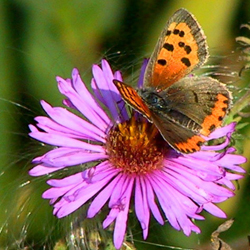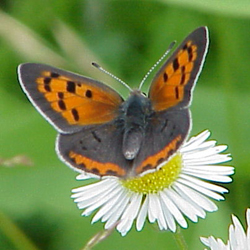Find a Butterfly
American Copper
Lycaena phlaeas americana
Named
Linnaeus, 1761

Taxonomy & Nomenclature
The eastern population of this species is believed by many authorities to represent an unintentional introduction of the Eurasian Small Copper (Lycaena phlaeas phlaeas) in the 18th century. This theory is supported by the eastern population‘s preferred food plants (See below). The disjunct arctic and alpine, when considered a subspecies or (rarely) a full species this form is known as Lycaena phlaeas americana or L. americana. The western mountain and arctic subspecies - which also occurs on arctic-alpine Scandinavia is called L.p. polaris.
Identification
Wingspan: 7/8 1 1/8". Of the three species of coppers occurring in Massachusetts American Copper is intermediate in size as well as being, by far, the most common. Distinguished from the slightly smaller Bog Copper (Lycaena epixanthe) by the extensive areas of orange scaling and from the Bronze Copper (Lycaena hyllus) by its distinctly smaller size.
Distribution
Two or three populations in North America: native populations in arctic-alpine habitats from Northwest Territories and Alaska south through the Rockies and Sierras; and the possibly introduced eastern population from southern Ontario east to Nova Scotia and south to Arkansas and Georgia. Throughout New England.
Status in Massachusetts
The American Copper is one of the state‘s more common butterflies. During the height of its flight periods it can be found in numbers in virtually all areas of the state in a wide variety of habitats. Maxima: 177, 4 June 1995, Mansfield (Bristol Co.).

Flight Period in Massachusetts
Three flights: mid May to late June, early July to late August, and late August to mid September. Extreme dates: 4 May 1991, W. Boylston (Worcester Co.), T. Dodd; 22 October 1994, Martha‘s Vineyard (Dukes Co.), A. Keith.
Larval Food Plants
In the east mainly Sheep Sorrel (Rumex acetosella): occasionally Curled Dock (R. crispus) both are introduced Eurasian weeds.
Adult Food sources
Many flowers; 49 species noted during Atlas period.

Habitat
The American Copper like its introduced host, Sheep Sorrel, has made a home in abandoned fields, power line cuts, railroad track right of ways, and similar disturbed habitats.
Life Cycle
EGG: Pale green to white; turban shaped with numerous crater like depressions formed by extensive ribing. OVIPOSITION: Eggs laid singly on leaves and/or woody stems. LARVA: Grass green or rose red, the former at times with rosy dorsal or lateral markings. CHRYSALIS: Tan with numerous dark speckles and generally ovoid in shape. Chrysalis stage lasts between 10 and 19 days. OVERWINTERING STAGE: Chrysalis. Adults can be found in flight through much of the summer and nectar on a variety of flowers including buttercups, clovers, and composites. The American Copper often calls attention to itself by flying out to challenge whatever moving object enters its area. After mating, eggs are laid on Rumex.
Account Author
Richard K. Walton



